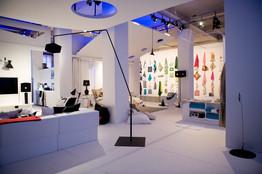Delayed from its originally planned autumn 2007 launch, H&M Home's range of pillows, towels, curtains and other home-textile products has been quietly rolled out over the past couple of weeks to customers in Scandinavia, Germany, Finland, Austria and the Netherlands, sold through established catalog and online sales channels.
"It's a little surprising they're not blowing their horns more about this," said Anders Wiklund, who analyzes retailers for Evli Bank in Stockholm.
At a time when consumers are tightening their belts and most companies are scaling back their ambitions, the lack of fanfare accompanying H&M Home's launch highlights the economic uncertainty in retail markets. It is in stark contrast to the store's festive annual launches of new collections by designers, such as Karl Lagerfeld and Stella McCartney, which can attract thousands of customers who line up for several blocks outside H&M stores.
 H&M
H&M
H&M displayed its new home textiles at a Berlin news event in November. But in a sign of caution among retailers, the business got under way without the usual fanfare of the company's launches.
"For a new range [the quiet rollout] minimizes the fashion risk," said Société Générale SA analyst Anne Critchlow. "When you're launching a completely new concept, which Home is, you're not sure immediately what's going to work...This is a way of testing the range and build it up over time."
Stockholm-based H&M is playing catch-up with Spanish rival Inditex SA, owner of the Zara clothing chain, which launched Zara Home interior furnishing stores in 2003. Clothing still generates the vast majority of Inditex's sales, which totaled €7.35 billion ($9.32 billion) in the company's fiscal third quarter ended Oct. 31, but Zara Home now has 241 stores in 14 countries, as well as an online store launched in 2007.
Zara Home's results have been dented by the economic downturn. The company didn't break out the division's sales in its third-quarter earnings report in November, but said the brand performed "below average."
H&M has already seen a slowdown in its fashion business, recording a drop in sales each month since August at stores open longer than a year. In its biggest market, Germany, where H&M generates a quarter of its revenue, unemployment has steadily risen to 7.9%, while retail sales have slowed; in December, home-furnishing sales fell 5.2% from a year earlier, according to data from the German central bank.
H&M, which has more than 1,700 boutiques around the world and reported annual revenue last year of 88.53 billion Swedish kronor ($9.83 billion), said it has no immediate plans to open H&M Home stores but said it is sticking to its expansion program for 225 new clothing stores this financial year.
"Generally H&M has done well in downturns compared with others," said Maria Lindblom, the H&M official in charge of the new Home unit. "We're investing in this long term."





